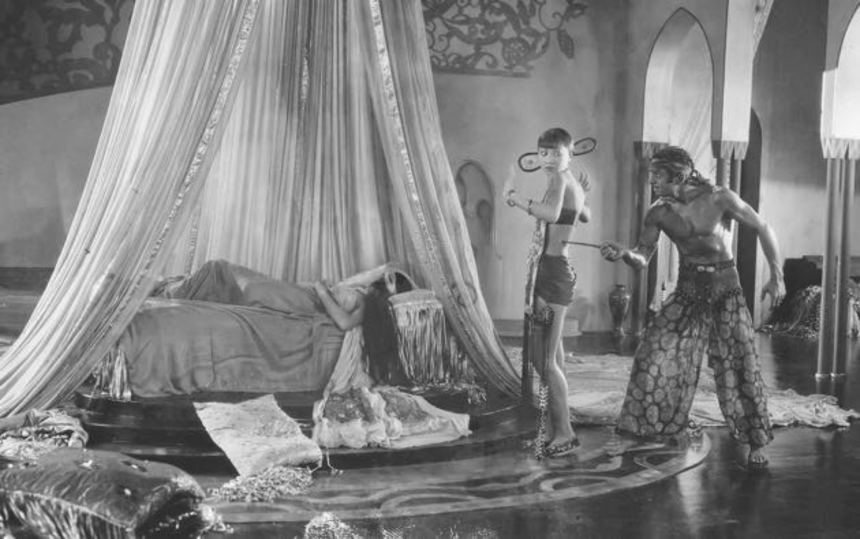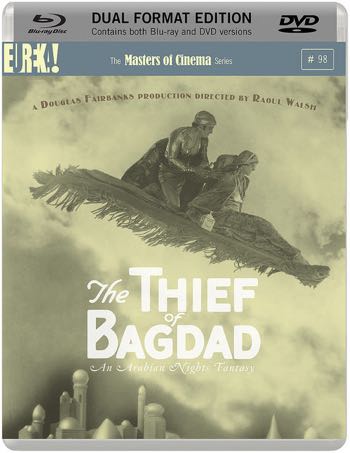Learning From The Masters Of Cinema: Raoul Walsh's THE THIEF OF BAGDAD

Douglas Fairbanks, "the first King of Hollywood", is today remembered as the star of numerous silent swashbuckling epics, including The Mark of Zorro, The Three Musketeers and Robin Hood. However, he attained the popularity and industry clout to get such projects off the ground (which were out-of-favour with the public at the time) making his name as a funny man in a string of comedies. A founding member of United Artists, and the very first president of the Academy of Motion Pictures Arts and Sciences, Fairbanks and then-wife Mary Pickford were Hollywood's first golden couple and at the peak of their popularity and power, when he set his sights on his most ambitious fantasy adventure yet, The Thief of Bagdad.
Loosely inspired by the collection of Asian folktales One Thousand and One Nights, the film tells the story of plucky street urchin Ahmed, who is bewitched by the beautiful daughter of Bagdad's Caliph and sets out on a series of increasingly magical adventures in order to win her hand over a trio of competing (and far wealthier) suitors. Very much a film of two halves, we are first introduced to the film's hero, the kingdom of Bagdad, and witness the seeds of romance sewn between Ahmed and the beautiful Princess (Julanne Johnson). We are then presented with the villainous Mongol Prince (Japanese actor Sojin Kamiyama), determined to take over the city for himself.
It is in the second half of the film that Fairbanks, Walsh and Co. really let rip with their wizardry and razzle dazzle, as Ahmed embarks on a series of death-defying adventures to acquire a rare treasure that will win him the princess' hand. Fairbanks was 40 years old at the time of filming, but instills his eponymous hero with more energy, athleticism and charisma than a man half his age. Stripped to the waist and built like an Olympic gymnast, Fairbanks' thief bounds around William Cameron Menzies' lavish, towering sets with a hyperactive abandon, matched only by the ambitious, pioneering special effects that would see The Thief of Bagdad referenced in scientific journals at the time of the film's release.
At a time when Christopher Nolan's Interstellar and James Gunn's Guardians of the Galaxy are monopolising the box office with their FX-heavy tales of deep space travel and photo-real extraterrestrials, Raoul Walsh's studio-bound silent romp should have its work cut out to impress modern audiences. However, almost the opposite is true. The Thief of Bagdad sparkles with an enthusiastic sense of wonder and willing suspension of disbelief. Sure, the mechanics of the film's winged horse or giant sea spider may be more visible than today's faultless computer generated marvels, but their tangibility and ingenuity is charming and delightfully theatrical in a way that makes even the best of today's effects appear cold and impersonal.
In fact, many of the showpieces in The Thief of Bagdad do still genuinely impress. The invisible cloak and the magic rope, for example, are just as praiseworthy examples of camera trickery today as they were 90 years ago. However, not even the flying carpet can compete with the agility and exuberance of Fairbanks himself. Whether trampolining in and out of giant vases or being flung from a horse into a rose bush, Fairbanks committed to his performances in a way precious few A-list stars dare (or are permitted) to today. Perhaps only Tom Cruise comes close - another actor-producer who has become a formidable brand unto himself.

While The Thief of Bagdad was directed by Raoul Walsh, a former actor (he played John Wilkes Booth in D.W. Griffith's The Birth of a Nation) who would go on to helm the likes of The Roaring Twenties, They Died With Their Boots On and White Heat, the film belongs to Douglas Fairbanks every step of the way. United Artists was created by Fairbanks, Pickford, Griffith and Charlie Chaplin as a way of giving the biggest stars of the period absolute creative power and freedom to produce and distribute the films they envisaged. For Fairbanks, The Thief of Bagdad was a dream project, the ultimate fantasy epic that would not only top any of the hugely successful hits he had released in the past few years, but would raise the bar in just what was technically capable on screen.
According to his son, the actor Douglas Fairbanks Jr., The Thief of Bagdad was his father's favourite of all his films, and for legions of fans at the time, and admirers to this day, that remains the case. Every bit the cinematic equal of the great German epics of the same period, like Lang's Die Nibelungen and Murnau's Faust, The Thief of Bagdad is a roller coaster ride featuring audacious sets, outlandish costumes, armies of extras, and a raft of mechanical and optical effects unparalleled in their day. Beyond the smoke and mirrors, the film also includes a number of daring casting decisions, from having actress Mathilde Comont portray the Persian Prince to casting American-born Chinese actress Anna May Wong in a pivotal role as the princess' duplicitous Mongol slave girl. Wong was Hollywood's first Chinese movie star, and would appear in a number of high-profile roles in big pictures, including Tiger-lily in Peter Pan before going toe-to-toe with Marlene Dietrich in Josef von Sturnberg's Shanghai Express.
The new dual-format Blu-ray/DVD release of The Thief of Bagdad from Eureka Entertainment's Masters of Cinema series continues the label's impeccable presentation of silent cinema's greatest offerings. The high definition 1080p restoration of the film looks stunning, allowing modern audiences to savour every nook and cranny of the film's incredible sets, as well as pick out every playful nod and knowing wink of Fairbanks' larger-than-life turn. The film is accompanied by an intoxicating score from Carl Davies, performed by the London Philharmonia Orchestra that will spirit viewers away, not only to the golden era of early Hollywood, but back to ancient Bagdad itself. The release also includes an entertaining and anecdote-riddled audio commentary from Fairbanks biographer Jeffrey Vance, as well as a video essay on the star illustrated by behind-the-scenes photos. The accompanying 40-page booklet features an essay from Laura Boyes, of the North Carolina Museum of Art.
A long-time fan of Michael Powell and Alexander Korda's 1940 adaptation (and wildly different telling) of The Thief of Bagdad, I had never seen this Douglas Fairbanks version prior to reviewing this disc. Having now seen the film twice in as many days it has swiftly become one of my favourite Hollywood adventure films, of the silent or any other era. Where there was potential for the film's setting to have been portrayed in a way that might seem troubling today, or the Jewish Fairbanks playing a muslim hero may have raised questions, there is instead only unabashed joy and wonder for a remarkable piece of innovative cinema that breaks new ground again and again over its breezy 140-minute running time. The Thief of Bagdad is movie magic in every sense of the word and a bona fide Hollywood classic.
The Thief of Bagdad will be released in the UK in a dual-format Blu-ray/DVD edition by Eureka Entertainment's Masters of Cinema series on 24 November.

Do you feel this content is inappropriate or infringes upon your rights? Click here to report it, or see our DMCA policy.






